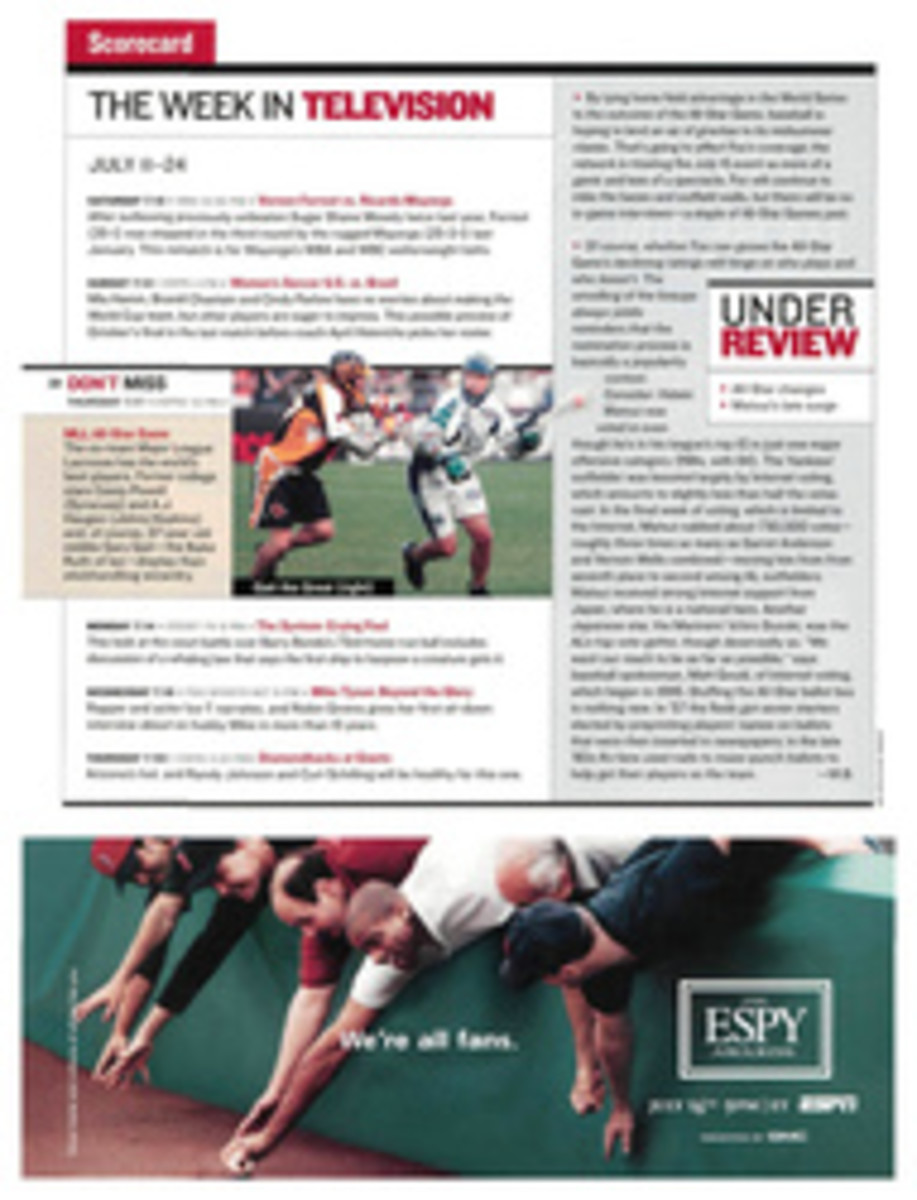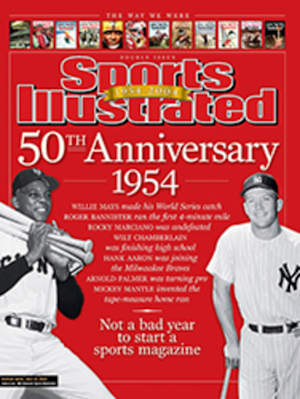
Teed Off Even as he crushed the Western Open field, Tiger Woods charged that some rivals gain added distance on their drives by using illegal clubs
The 100th Western Open was played last week, and Tiger Woods
supplied the nostalgia. He shot a tournament-record-tying 21
under and at one point on Sunday's back nine led by 10 strokes,
evoking an earlier era--say, three years and a left-knee
operation ago--when he routinely overpowered golf courses and
blew away the competition. Now 27 and an eight-year PGA Tour
veteran, Woods had limped into the Western ranked 30th on the
Tour in average driving distance (292.2 yards) and dogged by the
dreaded
s word (rhymes with chump) after cracking the top 10 in only one
of his previous five starts and failing to contend in the Masters
and the U.S. Open. By taking the Western, he became the first
player to win four or more events in a year for five straight
years. But as thrilling as it was to get a glimpse of the old
Woods, his triumph at Cog Hill Golf & Country Club in Lemont,
Ill., was all but overshadowed by a controversy of his own
making.
Last week, in response to questions during interviews, Woods
loosed the most inflammatory comments yet in his crusade against
what he alleges is the rampant use of illegal drivers on Tour.
The ensuing flap pitted player against player, sent commissioner
Tim Finchem scrambling for cover and left golf's foremost
ambassador, Woods, in the awkward position of having labeled some
of his colleagues cheaters. In the end the stink may have
revealed more about the marketing forces compelling Woods to
rationalize his shrinking drives than the murky issue of hot
clubs.
Woods's accusations come against a backdrop of increasingly
ferocious competition among rival equipment manufacturers to sign
Tour players, who exert a strong influence on which clubs the
weekend golfer purchases. Business became personal in February,
when Phil Mickelson, who earns more than $6 million a year to
endorse Titleist, called Woods's Nike equipment "inferior" in a
Golf Magazine Q and A and woofed, "He hates that I can fly it
past him now."
The charges stung Nike, which has struggled to establish its bona
fides since launching a golf division in 1998. (Nike Golf says
that it has grown 20% in the 16 months since it added clubs to
its clothing and equipment line, and that Nike clubs command
about 7% of the market.) The beswooshed drivers have received a
lukewarm reception on Tour since their introduction--though David
Duval was among the first to endorse them--and it hasn't helped
that Woods's driving has been uneven since he replaced his
Titleist driver with a Nike model in February 2002.
In the wake of Mickelson's remarks Nike's p.r. people reached out
to the golf press in an attempt to reframe the debate, telling
reporters that rival companies supplied their Tour players with
drivers that have excessive springlike effect. The USGA's
science-nerd term is coefficient of restitution (COR), which in
testing measures how fast a ball bounces off a stationary club
face, and any number higher than .830 is deemed nonconforming.
While prototypes of every driver are tested in laboratories by
the USGA, there is no mandatory spot-checking of the clubs that
manufacturers' reps pass out like business cards at Tour driving
ranges. Also, equipment companies have varying levels of
vigilance in their in-house testing, creating the possibility
that a player, knowingly or not, may use illegal equipment during
a tournament.
How much extra distance a hot driver produces has caused a heated
debate, but Tour pro David Toms spoke for many last week when he
estimated it was "three or four yards--maybe." So why all the
fuss? Selling more distance has been the golf industry's primary
marketing ploy since Big Bertha debuted in 1991; with every other
angle exhausted, the great COR debate can be seen as just another
sales gimmick. It's no longer just about hitting the ball a long
way--now you have to do it honestly.
With his $100 million contract from Nike, Woods is the game's
preeminent pitchman, so it was inevitable that he would
eventually weigh in. His interest in the issue was aroused during
the final round of May's Deutsche Bank-SAP Open in Germany, when
he put a TaylorMade driver in his bag. At first blush this change
was construed by Tiger watchers as a wake-up call for Nike, but
last week Woods said, "I was hitting it on the range. It was hot,
and I found out why." Woods says he shipped the driver to Nike's
R&D facility in Fort Worth, where, according to Nike spokesman
Dean Stoyer, tests showed a COR in excess of .830. TaylorMade
spokesman John Steinbach says, "That's possible. We tested the
batch but didn't test every head. But I'd love to know what kind
of test Nike used." (The company says it used one similar to the
USGA's.)
Woods cautiously addressed the driver issue at the U.S. Open, but
a week later, in a June 24 videoconference from his home in
Orlando, he told reporters, "There are some guys who you can hit
your three-wood past their three-wood, and all of a sudden you
get outdriven by 10, 20, 30 yards with their driver. Well,
there's something wrong with that picture.... All of the players
know who is doing it."
Not coincidentally, illegal drivers were at the top of the agenda
at a PGA Tour policy board meeting six days later at the Western
Open, after which Finchem announced that beginning in 2004
players would have access to voluntary testing of their drivers
at every tournament. The Tour will use the recently developed
pendulum test, in which the face of the driver is struck at
low-impact speeds by a metal weight suspended on a pendulum. The
test takes only a few seconds and measures the time of contact on
the club face, which, according to the USGA, is directly related
to the springlike effect of the clubhead. "There is no reason for
us to believe, nor do we have any evidence to indicate, that
there is any player on the PGA Tour using a driver that is
nonconforming," Finchem said.
Woods, who has displayed a prickly side in previous dealings with
the commissioner, halfheartedly called voluntary testing "a step
in the right direction" and then immediately undercut Finchem,
saying that he had confronted one player about his use of a
nonconforming driver--"You see a difference in how his ball
flies," Woods said--and that the widespread use of such clubs is
"more than anyone realizes."
The introduction of the mystery chiseler was a bombshell, but
Woods overreached. By refusing to name names, he made every long
hitter a suspect, and he also opened himself to accusations of
being an accessory to the crime. When asked about Woods's
revelation, U.S. Open champ Jim Furyk didn't mince words in
indicting Woods. "In the game of golf we kind of police each
other. Basically the rules say that if I see someone who breaks a
rule and I don't [report him], then I'm at fault also."
The war of words at the Western set off another round of clucking
in the locker room about what is really driving Woods. Veteran
Kirk Triplett said with a laugh, "It's human nature that if you
were at the top in driving distance, and now you're 30th, you
wonder why." Indeed, since joining the Tour in 1996, Woods had
never finished worse than third in driving distance through 2001.
Last year, his first with the Nike driver, he finished sixth.
Make no mistake, if Woods were obsessed only with distance, he
could certainly freewheel his way to the top of the charts. But
just as his old screaming-red Sunday shirts have given way to
more sophisticated shades, his game has become subtler and more
refined, with club specs to reflect this restraint. Woods swings
a 43.5-inch driver with a midsized clubhead, while many players
have gone to 46-inch models with the added length helping to
generate more speed for heads that are roughly the size of
toasters. Likewise, Woods still uses a steel shaft instead of the
much more popular graphite, which is lighter. So while Woods
remains golf's most creative shotmaker, best clutch putter and
most potent combination of power and precision, he is simply no
longer the longest hitter. Says Hank Kuehne, who heading into the
Western led the Tour with an average drive of 316.6 yards,
"Distances are going up, and people are going to have to get over
it."
Anyway, there is more to golf than just raw length. The Western
was a reminder that when Woods is putting well (he led the field
with 104 putts, tying a career low), he could probably win using
a shovel and a Pink Lady ball. Lest anyone think Woods has lost
all of his pop, he eagled his second hole of the tournament,
reaching the 564-yard par-5 11th with a six-iron, and later, at
the 16th hole, hit a "half-nothing eight-iron" to tap-in distance
on a 445-yard par-4, just two highlights in a course-record-tying
63.
So Woods goes roaring into the British Open next week, when his
thoughts on equipment are sure to pique the interest of the Fleet
Street rowdies. It was at last year's British Open that Woods's
first, tepid comments about the Augusta National membership
controversy--"There's nothing you can do about it"--led to yet
another outcry from those who would have him be a more active
social crusader. It is with hot drivers that Woods has found an
issue he believes in, and expect him to continue to bash away. Of
course, he ought to think about being the first in line for the
voluntary testing next year. The most interesting statistical
note from the Western Open? With a 303.4-yard average, Woods was
second in driving distance.
COLOR PHOTO: PHOTOGRAPH BY JOHN BIEVER A TIGER AGAIN Winning for the first time since March 23, a dialed-in Woods flashed his old power and precision.
COLOR PHOTO: FABIAN BIMMER/AP SEEING FOR HIMSELF In Germany, says Woods, he trotted out acompeting TaylorMade driver to see how hot it was.

